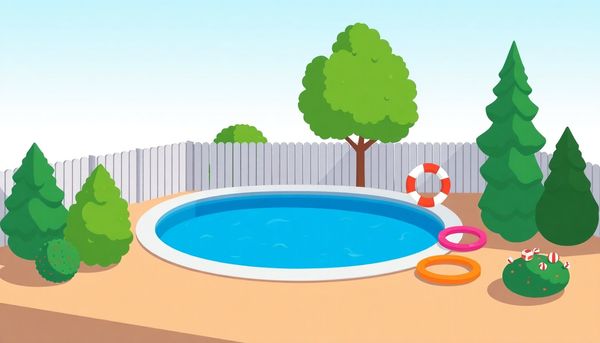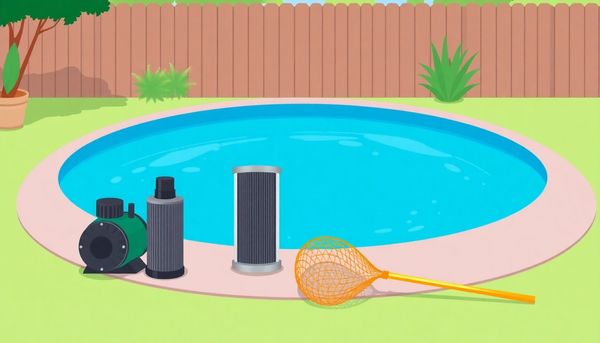Revive Your Pool: The Essential Guide to Acid Washing
April 02th, 2024
April 02th, 2024
A swimming pool is often the centerpiece of any backyard, promising refreshing dips on warm summer days and gatherings that extend into the twilight hours. However, over time, even the most pristine pools can fall victim to unsightly stains and mineral deposits. When regular cleaning falls short, acid washing emerges as the hero of the day, resurrecting the gleam and allure of your aquatic escape.
Years ago, a friend of mine, exasperated with his pool's persistent stains, turned to acid washing as a last resort. He recounted the process with a mix of awe and relief, noting how the technique seemed to breathe new life into the weary surfaces. This process involves applying a diluted acid solution to the pool's plaster or concrete surfaces, effectively removing a thin layer to eliminate stains and reveal the fresh layer beneath. It’s akin to a deep exfoliation for your pool, stripping away layers of grime that regular maintenance misses.
Approaching this task with care and preparation is crucial, as the chemicals involved are potent. Safety, therefore, becomes the priority, with protective gear and thorough planning essential to ensure the process is both effective and risk-free. Whether you're a seasoned pool owner or new to the world of backyard maintenance, understanding the ins and outs of acid washing can be the difference between a murky pool and a sparkling oasis. By mastering this technique, you reclaim not just the beauty of your pool but also the joy it brings to your home.

Acid washing a pool is no small affair, akin to a deep-cleaning ritual that demands respect and care. Before embarking on this task, one must prioritize safety above all else. This isn't just another chore on a weekend to-do list; it's a procedure that involves handling potent chemicals.
Preparing for an acid wash starts with understanding the tools and protective gear required. Think of it this way: just as a knight wouldn't charge into battle without armor, one shouldn't handle acid without proper protection. Industrial-grade masks, chemical-resistant gloves, and protective eyewear are essential to shield against harmful fumes and splashes. It's not about looking the part, but ensuring that every inch of your skin and respiratory system is safeguarded.
From personal experience, I remember assisting a friend with an acid wash and realizing the importance of a well-ventilated environment. We chose a calm, windless day to ensure fumes didn’t waft into unwanted areas, like the neighbor's patio or, worse, our lungs. Safety goggles and long sleeves further reinforced our defenses.
Moreover, knowing your local regulations about wastewater disposal is crucial. Acid can have severe environmental impacts if not disposed of correctly. Before beginning, consult local guidelines to prevent potential fines and protect your local ecosystem.
In summary, the key to a successful acid wash is meticulous preparation and unwavering attention to safety. This ensures not only the longevity of your pool but also the well-being of everyone involved.
Acid washing a pool is no small feat, and safety should be at the forefront of your mind. Before even considering the task, think of it as preparing for a mission. The first step? Ensuring you're clad in the right armor to face the challenge ahead: personal protective gear. This isn’t just about avoiding a splash or two; it’s about safeguarding your well-being.
Remember the last time you grilled outdoors and the wind shifted, sending a gust of smoke your way? Now imagine that smoke is a potent chemical mist. That's why a respirator is essential, not just any mask. Choose one designed to block hazardous fumes, ensuring you can breathe easy and protect your lungs.
When it comes to hands-on work, the importance of sturdy, chemical-resistant gloves can’t be overstated. A friend once jokingly compared wearing them to donning superhero gloves, but when you're handling acid, it's no joke. These gloves are your first line of defense against unpleasant burns. After use, a rinse followed by a soda ash treatment will neutralize any residual acid, keeping those gloves in top form for future use.
Let’s not forget the eyes, arguably the most vulnerable part of your body. Safety goggles aren't just a suggestion; they're a necessity. A splash of acid in the eyes can have serious consequences, so strap those goggles on before you start and don’t remove them until the area is thoroughly rinsed and safe. Prioritizing protective gear isn’t merely about following rules; it’s about ensuring you emerge from this task unscathed, ready to enjoy the fruits of your labor—a sparkling pool.
Vinyl pools, while a popular choice for their smooth surfaces and affordability, have a distinct Achilles' heel—acid. Unlike their concrete or gunite counterparts, vinyl pools simply can't withstand the harsh treatment of an acid wash. A close friend of mine learned this lesson the hard way. In an attempt to revive their vinyl pool's appearance, they mistakenly treated it using methods meant for plaster pools, leading to a severely damaged liner and an unexpected replacement bill.
For those with vinyl pools, it's crucial to understand that even a diluted acid mixture can be catastrophic. Acid eats through the vinyl like paper in a rainstorm, leaving behind irreparable damage. Instead, focus your efforts on regular maintenance with gentle, vinyl-safe cleaning products. These are designed to tackle stains without compromising the liner's integrity.
If stains persist, consult a professional who can recommend the best course of action without resorting to acid. Preventative measures, such as maintaining balanced water chemistry and using covers when the pool is not in use, can also help stave off unsightly marks. Remember, treating a vinyl pool with the care it requires will not only extend its life but also save you from costly repairs. In this case, less aggressive approaches truly are more.
Dealing with acid waste demands not only caution but also responsibility, especially when it comes to environmental impact. After completing the acid wash, you’ll be left with a pool of wastewater in the deep end, containing both acid and soda ash. This concoction, although neutralized, still requires careful disposal to prevent harm to your surroundings.
First, check your local regulations. Many communities have specific guidelines for the disposal of such chemical mixtures, and non-compliance can lead to fines. Contacting your local water authority will provide you with the best practices for disposal in your area. Some regions might require you to transport the waste to a designated facility, while others might allow it to be diluted further and safely discharged.
Once you’re informed of the proper procedure, ensure the mixture's pH level is as close to neutral as possible. Use a water test kit to confirm this, and add more soda ash if necessary to achieve the desired balance. This step is vital in minimizing any potential damage to plant life or water systems.
Finally, dispose of the wastewater safely, following the plan you established with your local authorities. Safety extends beyond personal protection gear; it encompasses how you handle and treat the environment as well. By responsibly managing the disposal of acid waste, you contribute to the sustainable care of both your pool and the planet.

Embarking on the mission to acid wash your pool begins with assembling the right tools. It's like preparing for an adventure, where having the proper gear makes all the difference between a smooth journey and a perilous trek. Ensuring you have the correct equipment is crucial not only for efficacy but also for your safety.
First, let's talk about protection. Acid washing requires more than just a sturdy pair of gloves. You'll need chemical-resistant gloves, specifically designed to withstand acidic substances. These aren't your everyday garden gloves, but specialized gear that will shield your hands from the harshness of muriatic acid. Complement your hand protection with a high-quality respirator designed to filter harmful fumes. Trust me, the last thing you want is to breathe in those noxious vapors.
Next, safety goggles are non-negotiable. Splashing acid can cause severe eye damage, and a good pair of goggles will provide the necessary shield. And remember, attire counts too—long sleeves, pants, and closed-toe shoes are essential to cover exposed skin.
On the tool side, you'll need a durable acid brush for scrubbing, a watering can for applying the acid mixture, and a couple of garden hoses—one for rinsing and the other for neutralizing the acid with soda ash. Lastly, a submersible pump will be your ally in managing the acid-water mix efficiently.
Gather these essentials before you begin. With everything at your fingertips, you'll be ready to tackle that pool with confidence, ensuring a gleaming finish without compromising safety.
Handling acid requires more than just courage; it demands the right protective gear. When preparing to acid wash your pool, think of this gear as your armor against potential hazards. Start with a proper respirator. Muriatic acid's fumes aren't just unpleasant; they can be downright dangerous, especially if you've ever struggled with respiratory issues like asthma. A simple dust mask won't cut it. Invest in a respirator designed to filter out chemical fumes—your lungs will thank you.
Next, consider your hands. Ordinary household gloves might seem tempting for convenience, but they aren’t up to the task. Chemical-resistant gloves are essential. I remember a time when my neighbor tried shortcutting with regular kitchen gloves and regretted it almost immediately; the acid ate right through, leaving a nasty burn. Opt for gloves that are specifically designed to resist acidic substances, and be sure to rinse them thoroughly when you're done.
Your eyes are equally vulnerable. Always wear safety goggles—good ones. Acid splashes can cause severe eye injuries, even blindness. Trust me, spending a little extra on quality goggles is worth avoiding a trip to the emergency room.
Finally, cover up. Long sleeves, pants, and closed-toe shoes minimize skin exposure. If it’s sweltering outside, it might be tempting to skip the long sleeves, but a brief moment of discomfort is far better than the pain of an acid burn. Select chemical-resistant boots if you can, and remember to rinse them off thoroughly once the job is done. With the right gear, you’ll be ready to safely tackle your pool’s acid wash.
Selecting the right materials for your pool is as crucial as choosing the perfect color for a room—it can make or break the entire experience. When it comes to acid washing, the materials your pool is made from dictate the approach you should take. Not all pools are created equal, and using the wrong technique on the wrong material can lead to costly damages.
Concrete and gunite pools are your best friends in this scenario. These materials can withstand the harsh nature of acid washing, as they are robust and designed to handle the stripping of a thin plaster layer. My neighbor once made the mistake of using an acid wash on their vinyl-lined pool, thinking it would remove the stains. Unfortunately, they ended up with a ruined liner and a hefty repair bill. If your pool has a vinyl liner, steer clear of acid washing, as the acid eats right through the material.
Consider your pool’s age and the condition of its surface before proceeding. A pool plastered decades ago may be nearing the end of its life span, and aggressive acid washing could expose underlying issues. On the flip side, newer surfaces can withstand an acid wash more gracefully, revealing a pristine layer beneath. Take the time to assess your pool's material compatibility to ensure this deep clean leaves your oasis refreshed, not ravaged.
Acid washing a pool is a serious task that demands the right tools to safeguard both your health and your pool. Venturing into this process without proper equipment is akin to entering a battle unarmed. The cornerstone of this preparedness is a robust respirator mask. Working with muriatic acid means exposure to potent fumes that can irritate the respiratory system. Opt for a mask specifically designed to block acid fumes—your lungs will thank you.
Next, consider your hands. Ordinary gloves simply won't cut it here. Chemical-resistant gloves are essential to prevent acid from seeping through, which could otherwise result in painful burns. Once you've completed the task, thoroughly rinse these gloves and treat them with soda ash to neutralize any remnants of acid.
Your eyes, too, need protection. Safety goggles should be non-negotiable in your acid-handling toolkit. They shield against splashes that could potentially harm or even blind you. Remember, even a small splash is too much when it comes to acid.
Don’t forget about your clothing. Long sleeves, pants, and closed-toe shoes shield your skin from accidental splashes. Ideally, wear chemical-resistant boots to protect your feet thoroughly. These precautions are not just for peace of mind—they're vital steps in ensuring safety and efficiency in pool maintenance. With the right tools, you can transform your pool safely, preserving its beauty and your well-being.

When preparing to tackle an acid wash for your pool, putting safety first is paramount. It's a task that demands respect for both the chemicals involved and the potential risks. Delving into this chore without the right protective gear is akin to diving into the deep end without knowing how to swim. Trust me, you don’t want to end up in a situation that requires more than just a band-aid.
Start with your hands. Ordinary gloves won’t cut it; you need chemical-resistant gloves that are specifically designed to withstand acid. I once made the mistake of using basic rubber gloves during a minor chemical task, and the brief exposure left a vivid reminder of how essential the proper equipment is. When it comes to eyewear, think beyond sunglasses. Safety goggles are your best friend here—anything less could leave you with not just watery eyes but possibly a trip to the hospital.
For clothing, opt for long sleeves and pants. Even on a hot day, it's better to sweat a little than to suffer a chemical burn. Closed-toe shoes, ideally chemical-resistant boots, will shield your feet from accidental spills or splashes. The key to all this preparedness is avoiding the unexpected; it only takes a second for things to go wrong.
In the end, the right gear is your silent partner in this project. Before you even open that container of acid, ensure you’re dressed for the part. This isn’t just about getting a job done—it's about getting it done safely.
Handling acid is no small feat, and it demands the right gear. When you're ready to tackle that stubborn pool grime, remember: safety comes first. Picture stepping into a chemistry lab—because that’s essentially what your pool becomes during an acid wash. Your first line of defense? A high-quality respirator mask. Not just any mask will do, especially with the fumes from muriatic acid. Investing in a respirator designed to filter out the harsh chemicals is a non-negotiable step to protect your lungs.
Moving on to your hands, standard gloves won’t cut it. You’ll need chemical-resistant gloves that can withstand acid exposure. Imagine the horror of realizing too late that your hands are bare against the caustic elements. To complement your gloves, slip on a pair of goggles. Not to sound dramatic, but a splash of acid in the eyes can lead to severe damage, potentially affecting your vision permanently.
Your wardrobe isn’t complete without long sleeves, pants, and closed-toe shoes. It's tempting to dress lightly on a hot day, but think of the discomfort a chemical burn can cause. Every inch of skin covered is an inch protected. Lastly, chemical-resistant boots add an extra layer of safety for your feet. When you finish, rinse all your gear thoroughly to neutralize any lingering acid. Ensuring your safety gear is in place turns your daunting chore into a manageable task, keeping you safe while you reveal your pool’s hidden beauty.
When faced with the task of acid washing a pool, safety should be your paramount concern. The term 'acid' isn't just for dramatic effect; it signifies the powerful nature of the chemical you'll be handling. Your skin and eyes, the most vulnerable parts of your body, deserve top-notch protection.
Let's begin with your eyes. A small splash of acid can lead to severe damage, potentially impairing your vision. Therefore, sporting safety goggles isn't just a suggestion—it's a necessity. These goggles shield your eyes from accidental splashes and the acid’s potent fumes. Make sure they fit snugly, without gaps that could allow any fumes to sneak in. Once you're done, rinse the goggles thoroughly before storing them away.
Now, onto your skin, which is equally at risk. Ordinary gloves won’t suffice here; you need chemical-resistant gloves designed specifically for handling acidic substances. These gloves form a barrier that prevents the acid from making contact with your skin. It's also wise to wear long sleeves and pants, ensuring your clothing is made from a material that offers an extra layer of protection. And remember, if any acid does touch your skin, rinse it off immediately with plenty of water to minimize damage.
By prioritizing your safety with the right gear, you can focus on giving your pool the rejuvenation it needs without putting yourself in harm's way.
Acid washing a pool is a formidable task, akin to wielding a powerful tool that demands respect and caution. To ensure your safety while undertaking this chore, chemical-resistant gear is not just recommended; it is essential.
First and foremost, consider your skin. Ordinary gardening gloves won't cut it here. You need specialized chemical-resistant gloves designed to withstand the harsh effects of acid. This level of protection keeps your hands safe from potential burns, which can range from minor irritations to serious injuries if the acid penetrates inadequate barriers. And remember, if any acid contacts your skin, rinse immediately with copious amounts of water to mitigate damage.
Next, protect your eyes with safety goggles. Acid splashes can happen in the blink of an eye, and without proper eyewear, the consequences could be severe, potentially threatening your vision. Always choose goggles that are resistant to chemical splashes and fogging to maintain clear vision throughout the task.
Your wardrobe should also include long-sleeved shirts and pants, made from sturdy, non-absorbent materials. This attire acts as a barrier against accidental splashes, preserving your skin from burns. Additionally, chemical-resistant boots are a must to shield your feet—not just any closed-toe shoes will suffice.
Working with acid requires meticulous attention to safety details. By donning the right gear, you not only safeguard your well-being but also enhance your confidence and effectiveness in tackling the task at hand. This precautionary approach ensures that you transform your pool into a sparkling oasis without compromising personal safety.

Handling acid requires attention and care that goes beyond the usual pool maintenance tasks. It's a bit like preparing your favorite spicy dish—one wrong move and you could end up with more than just a little heartburn! When you're getting ready to acid wash a pool, understanding and respecting the potency of muriatic acid is key. Always start by choosing a day with calm weather; wind is not your friend here. Remember a time when a gust of wind turned an innocent picnic into a napkin-chasing marathon? Now imagine that, but with acid fumes. Not something you want to experience.
Dressing the part is crucial. Long sleeves, pants, and closed-toe shoes are your armor, guarding against potential splashes. And don’t skimp on quality goggles and chemical-resistant gloves—your eyes and skin will thank you. I once tried to take on a similar task with inadequate protection, thinking, "What could go wrong?" Let's just say I learned quickly that the answer is "quite a lot."
Organization can’t be overstressed. Before introducing acid to water (always in this order to prevent dangerous reactions), ensure you have everything in place—from the soda ash for neutralization to a reliable watering can for precise application. Maintaining a clear workspace and having all tools within reach will help you manage the process smoothly. By approaching acid handling with a blend of caution and preparation, you’ll not only safeguard yourself and your pool but also walk away with a sparkling result worthy of your effort.
In the realm of pool maintenance, acid washing holds a reputation for both its effectiveness and its inherent risks. This process is not your ordinary cleaning task; it involves handling hazardous substances that demand respect and caution. The importance of wearing protective safety gear cannot be overstated when you're about to engage in such a meticulous procedure.
Before you even think about mixing the acid, arm yourself properly. A few years back, I had a friend who underestimated this process, thinking that a simple face mask and kitchen gloves would suffice. Unfortunately, it resulted in minor skin burns and a serious lesson learned. So, learn from his mistake—opt for a respirator specifically designed to block acid fumes. Regular masks simply won’t cut it when you're dealing with the potent fumes of muriatic acid.
Chemical-resistant gloves are another non-negotiable. Not just any gloves will do; they must be sturdy enough to stand up to direct contact with acid. If you're not convinced, try this little test: pour a drop of vinegar on the gloves you're considering. If they show any signs of weakness, move on to a more robust option. Additionally, keep a pair of safety goggles on at all times. Even a tiny splash can cause significant eye damage, something no one wants to deal with.
Dress the part, too. Long sleeves, pants, and closed-toe shoes protect more than just your style—they're your first line of defense against accidental splashes. A small investment in quality gear can save you from a world of pain. As you suit up, remember, safety isn't an option; it's a prerequisite.
Opening a bottle of muriatic acid may feel akin to uncorking a genie of potential danger. As the pungent fumes waft into the air, ensuring proper ventilation becomes paramount. Indoor pools or those nestled within enclosed spaces present unique challenges. The atmosphere can quickly become a cauldron of noxious gases if not managed with care.
Start by opening all doors and windows to encourage a cross-breeze, essentially inviting fresh air to sweep away the hazardous fumes. If possible, employ fans strategically placed to direct airflow out of the area. Remember, it's not just about dilution; it's about ensuring that every breath you take isn't tinged with the sting of acid.
For those who’ve ever cooked in a kitchen without a vent, the experience can be suffocating. A similar principle applies here, multiplied by the peril of acid vapors. A friend once shared a tale of absent-mindedly scrubbing tiles without adequate ventilation. After moments of dizziness, he understood why such precautions are stressed.
If your pool sits inside a larger structure, consider portable ventilation systems. These are invaluable in efficiently channeling fumes out, akin to a lifeline in a risky endeavor. Some might feel tempted to overlook this step, thinking the task manageable without it. However, safety should never play second fiddle to convenience.
Taking the correct precautions creates a safe environment, allowing you to focus on the task at hand. Your lungs and peace of mind will thank you for it.
Handling acid requires more than just a steady hand and a brave heart—responsible disposal is equally crucial. Once your pool sparkles with a refreshed layer of plaster, you face the task of neutralizing and safely disposing of the acidic residue. Neglecting this step can have dire consequences for both your property and the environment.
To start, neutralizing the acid is imperative. Soda ash, a staple in any acid wash toolkit, works wonders here. As the acid pools at the deep end, gradually introduce soda ash, stirring it in to balance the pH. Aim for neutrality; for reference, two pounds of soda ash typically neutralize one gallon of acid. Keep testing the pH until you achieve a safe level.
Local regulations can't be ignored in this process. Municipalities often have stringent rules on wastewater disposal, especially when it involves hazardous substances like acid. Check with local authorities to ensure you’re compliant. Some areas may even provide specific disposal facilities or services.
Once neutralized, a submersible pump becomes your ally, removing the water mixture efficiently. Ensure no residual acid remains by following up with a final rinse, which should also be pumped out and properly handled. Remember, improperly disposed acidic water can wreak havoc on vegetation and wildlife.
By diligently neutralizing and disposing of the acid mixture, you not only protect your immediate environment but also contribute to a broader ecological safety. It's a step that rewards both your conscience and your community.
Managing acid safely during an acid wash isn't just about the application—it's about what comes after. Neutralization and proper disposal are crucial. Once you've thoroughly scrubbed and rinsed the pool, you're left with a mixture of water and acid. Dumping this concoction into your garden or down the storm drain isn't an option. Instead, you'll need to neutralize it. Soda ash, or sodium carbonate, becomes your best ally here. By sprinkling soda ash into the collected water, you raise the pH level, effectively neutralizing the acid. A general rule of thumb is to use about two pounds of soda ash for each gallon of acid used, but always check the manufacturer’s guidelines for precise ratios.
After neutralization, it's time to carefully pump out the water. A submersible pump works wonders here, ensuring that the neutralized wastewater is safely funneled away from the pool. Be sure to follow local regulations on wastewater disposal; some areas may require transport to a treatment facility to prevent any environmental impact.
Remember, safety extends beyond the wash itself. Double-check the water’s pH before disposal with a simple test kit, and never skip the neutralization step. By taking these extra precautions, you not only protect your pool but also the environment, ensuring a clean and fresh start for your pool without unintended consequences.
Handling acid during a pool wash is an endeavor that demands both caution and preparation. The potent nature of muriatic acid, the chemical typically used, makes safety a priority. You may recall the first time you handled a potentially hazardous substance—perhaps in a chemistry lab at school. Remember the nervous excitement mixed with fear? This is similar, but with real consequences.
First and foremost, gear up properly. Safety is not a suggestion but a necessity. Equip yourself with chemical-resistant gloves, a respirator mask that effectively blocks fumes, and safety goggles to shield your eyes. A long-sleeved shirt, long pants, and closed-toe shoes provide additional protection against accidental splashes. Think of it as suiting up for a battle against grime, with acid being both your ally and a formidable opponent.
When mixing the acid with water, always introduce the acid into water, not the other way around. This simple step prevents dangerous reactions that can splash caustic liquid. Imagine the chaos if you pour water into acid—it’s akin to adding a spark to a powder keg.
Finally, ensure your workspace is devoid of distractions. Pets and children should be kept far from the area to avoid any mishaps. Even a gentle breeze can carry harmful fumes into unintended spaces. Armed with preparation and respect for the process, handling acid can be a manageable task, ensuring your pool is clean and safe for future swims.

This article provided insights into maintaining your pool. Start your pool care journey today!
Want to become a pool maintenance expert? Our free Pool School course covers everything you need to know about pool care. From basic maintenance to advanced troubleshooting, you'll learn how to:
Join over 10,000 pool owners who have already transformed their pool care routine. Get started with our free Pool School course today!